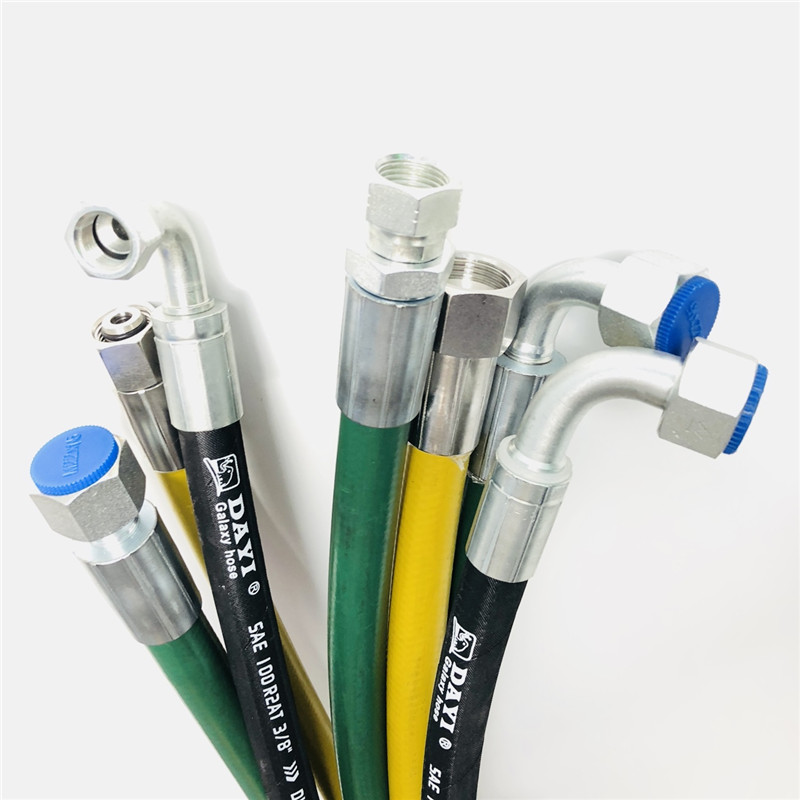335345435
Nov . 09, 2024 15:20 Back to list
High-Quality OEM Steel Wire Spiral Hydraulic Hose for Reliable Performance and Durability
Understanding OEM Steel Wire Spiral Hydraulic Hoses
In today's industrial world, hydraulic systems play a pivotal role in various applications, from construction equipment to manufacturing machinery. One of the essential components in these systems is the hydraulic hose, specifically the OEM steel wire spiral hydraulic hose. This type of hose is engineered to provide durability, flexibility, and resistance to high pressure, making it an ideal choice for demanding environments.
The Significance of Hydraulic Hoses
Hydraulic hoses are crucial in transmitting fluid power within hydraulic systems. They connect various components, such as pumps, valves, and actuators, allowing for the transfer of energy efficiently. When it comes to high-pressure applications, standard hoses may not withstand the stress, hence the need for specialized hoses like the steel wire spiral hydraulic hose.
What is an OEM Steel Wire Spiral Hydraulic Hose?
OEM stands for Original Equipment Manufacturer. An OEM steel wire spiral hydraulic hose is designed to meet specific requirements set by original equipment manufacturers for their machinery. These hoses are constructed with multiple layers of steel wire spirals, providing exceptional strength and flexibility. The combination of robust materials ensures that the hose can withstand high-pressure environments typically found in heavy-duty machinery.
Features of OEM Steel Wire Spiral Hoses
1. High Pressure Resistance The steel wire spirals within the hose significantly enhance its ability to resist burst pressure, making it suitable for applications where extreme pressures are common. These hoses can typically handle pressures ranging from 3000 PSI to over 6000 PSI, depending on their design and diameter.
2. Flexibility and Bend Radius Unlike rigid piping systems, steel wire spiral hydraulic hoses offer greater flexibility. Their design allows for tighter bend radii, making them easier to install in confined spaces without risking kinking or damage.
oem steel wire spiral hydraulic hose

3. Durability Constructed from high-quality rubber and reinforced with steel, these hoses are designed to endure harsh environmental conditions, including exposure to oils, chemicals, and extreme temperatures. They exhibit excellent abrasion resistance, ensuring longevity even in rugged settings.
4. Temperature Range OEM steel wire spiral hydraulic hoses can operate effectively in a wide range of temperatures, typically from -40°F to +212°F (-40°C to +100°C), allowing them to perform in various industrial settings.
Applications of Steel Wire Spiral Hydraulic Hoses
These hoses are widely used across different industries, including
- Construction In earthmoving equipment and cranes, where high-pressure hydraulic systems are essential for lifting and moving heavy loads. - Manufacturing In assembly lines and processing plants, where hydraulic machinery is used for repetitive tasks requiring precision and power. - Agriculture In tractors and harvesting machines that utilize hydraulic systems for efficient operation. - Marine In ships and offshore drilling rigs, where hoses need to withstand harsh marine environments.
Choosing the Right Hose
When selecting an OEM steel wire spiral hydraulic hose, it is crucial to consider factors such as the working pressure, temperature range, and compatibility with the hydraulic fluid being used. Additionally, ensuring that the hose meets the specific standards and certifications relevant to your industry will guarantee safety and performance.
Conclusion
In summary, OEM steel wire spiral hydraulic hoses are indispensable in high-pressure hydraulic applications, offering unmatched strength, flexibility, and durability. Their ability to withstand extreme conditions makes them a top choice for industries that rely on hydraulic systems. As technology advances, these hoses will continue to evolve, further enhancing their efficiency, safety, and versatility. Whether you’re in construction, manufacturing, agriculture, or marine applications, investing in high-quality hydraulic hoses is essential for ensuring the optimal performance of your hydraulic systems.
-
High-Quality Distribution PTFE Hose for Industrial Flexibility
NewsJul.23,2025
-
Durable Pressure Washer Rubber Hose for Hot Water & High Flexibility
NewsJul.22,2025
-
Twin Hydraulic Hose for Efficient Fluid Transfer | Durable & Flexible
NewsJul.22,2025
-
Twin Hydraulic Hose | High Pressure & Durable
NewsJul.21,2025
-
Discount Hydraulic Hose Factories | Top Quality & Discounts
NewsJul.20,2025
-
EN856 4SP Hydraulic Hose - High Pressure & Durable
NewsJul.20,2025



